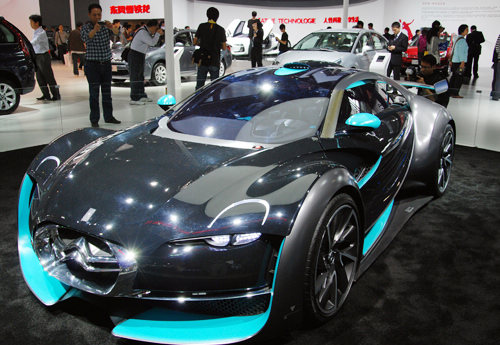|
 |
|
AUTO MANIA: A new Citroen car model on display at the 2011 Guangzhou International Automobile Exhibition (YUAN HONGWEI) |
International automakers have set their sights on the China market. At the Ninth China (Guangzhou) International Automobile Exhibition held on November 22-28, global auto brands gathered to show off their latest car models and turn the exhibition into a platform for launching new models and impressive concept cars in the global market. The international automakers have also formulated detailed plans for expanding or entering the Chinese market.
This was unimaginable 10 years ago, when international auto giants turned a blind eye to China. That was before China became a member of the WTO.
China was admitted to the WTO on December 11, 2001. After that China lowered tariffs on imported products. The tariff rate on imported cars was reduced from 80 percent to 25 percent and tariffs on car parts and components were reduced from 35 percent to 10 percent. Quota restrictions on imported cars were eliminated.
"This caused car prices to drop to a reasonable level conforming to market rules and the affordability of Chinese consumers. It also allowed the auto market to boom," said Rao Da, Secretary General of the China Passenger Car Joint Conference.
Since 2001 the sales volume of cars in China has increased on a year-on-year basis. Various foreign producers have entered China. Domestic capital is being used to nurture the industry. Many domestic brands have been established. In 2010, a total of 18 million automobiles were sold in China, nearly eight times that in 2001, ranking first in the world.
When China first entered the WTO, its auto output was less than one sixth that of the United States. Now China's auto output has doubled that of the United States. In 2001 the total output value of China's auto industry was only 443.3 billion yuan ($69.7 billion), but in 2010, it reached 4.34 trillion yuan ($682.39 billion).
The rapid growth shocked international auto giants. They began to look at the Chinese market differently.
For international automakers that entered the Chinese market early, China has become their primary source of profit growth. That trend continued in Guangzhou this year, with big names like Bentley, Benz and Cayenne reaping handsome profits in the country.
Media reports 10 years ago assumed that China's entry into the WTO would prove catastrophic for the country's industries, particularly the auto industry. Many people were worried that after tariffs were reduced by a large margin, imported cars would conquer the Chinese market, driving domestic companies off the road.
"The disaster everyone was predicting didn't come to pass. Instead, we have seen high-speed development beyond expectations," Rao said.
The high tariffs before had protected not only China's backward auto industry, but also foreign auto companies that had entered China earlier. A fully opened market formed after China's entry into the WTO has allowed access to all foreign automakers. As a result, competition among the foreign players has forced them to bring the best models to China.
As an added bonus, advanced technologies and management expertise they have brought along with their investment have greatly improved the Chinese auto industry.
Zhang Yansheng, a researcher with the Academy of Macroeconomic Research affiliated to the National Development and Reform Commission (NDRC), said when China first entered the WTO, people were most concerned about whether its disadvantageous industries, such as auto manufacturing, agriculture and the financial sector, could stand up to international competitors. During the past decade, these industries have formed their own competitive advantages under an open market-oriented economy.
Opening allows the whole auto manufacturing industry to move forward. It also gives Chinese automakers the chance to develop.
In its dance with foreign competitors, China has responded swiftly. Yu Jianhua, Assistant Minister of Commerce, said over the past decade China has explored a road of promoting development and reform through opening up. Just three years after it entered the WTO, China rewrote laws and regulations that didn't conform with WTO rules. The central and local governments amended or abolished 90,000 laws and regulations.
| 